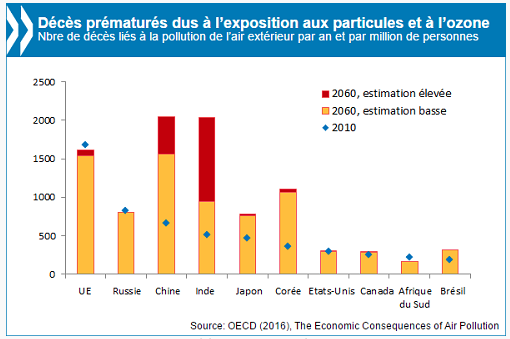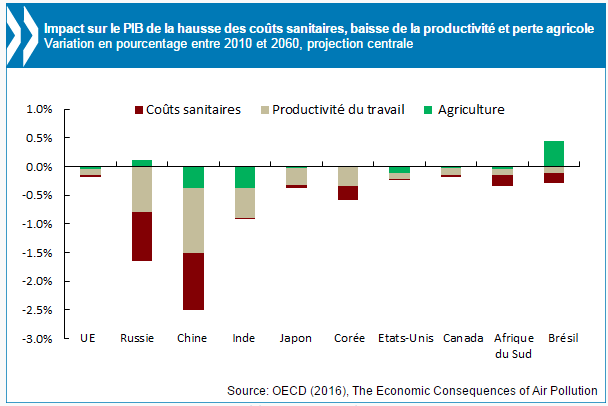Outdoor air pollution could cause 6 to 9 million premature deaths by 2060 and cost 1% of global GDP. These are the findings of a new OECD report.
-1465548988.jpg)
“If we don’t act, outdoor air pollution could lead to 6-9 million premature deaths by 2060 and cost 1% of global GDP – or some $ 2.6 trillion a year – due to the days sick leave, additional medical costs and declining agricultural yields ”, this is the warning issued by the authors of the latest OECD report (1) published on Thursday.
Entitled ” The Economic Consequences of Air Pollution », he estimates that the consequent reduction in global economic production by 2060 will amount to around USD 330 per person. Annual health care costs linked to air pollution would reach 176 billion dollars compared to 21 billion dollars in 2015. And the number of work days lost due to illnesses linked to air pollution would increase from 1.2 billion to 3.7 billion.
Over 3 million deaths in 2010
“The number of lives cut short by air pollution is already terrifying, and its potential increase in the decades to come is frightening. If that was not a sufficient reason to act, this report shows that inaction will also have a considerable economic cost, ”said OECD Environment Director Simon Upton at the 8th Ministerial Conference “An environment for Europe” in Batumi, Georgia. “We must prevent these projections from becoming a reality,” he insisted.
And there is urgency. Outdoor air pollution has already caused more than 3 million premature deaths in 2010, the elderly and children being the most vulnerable. The projections of the OECD thus imply a doubling, even a tripling of premature deaths due to air pollution, “that is to say one premature death every four or five seconds by 2060”, specifies the Organization. in a press release.
Most endangered India and China
The biggest increases in air pollution-related mortality are expected in India, China, Korea and Central Asian countries like Uzbekistan, “where population growth and congestion in urban areas will make a difference. that more people will be exposed to emissions from power plants and to exhaust fumes ”.
Premature death rates are predicted to triple between 2010 and 2060 in China and quadruple in India. In contrast, death rates would stabilize in the United States and decline in most Western European countries, “thanks in part to efforts to switch to cleaner energy sources and modes of transportation.”

Citizens involved
And it is also in China (but also in Russia, India, Korea and in the countries of Eastern Europe and the Caspian region) that the losses of GDP would be the strongest, “the health costs and the fall of labor productivity affecting production ”. Poor air quality will hit China’s economy harder than India’s. The authors’ explanation is that “demographic differences and the structure of household savings will have a greater impact for the Chinese economy on declining labor productivity and increasing medical costs.” Arguments that will perhaps revive speculations predicting that India will become the 3rd world power by 2030?
The reduction in agricultural yields as a result of air pollution will strain the economies of most countries. With the exception of Brazil, Russia and some Latin American countries “where agricultural activities should be less affected, resulting in better export competitiveness and consequently economic gains”.

Finally, the report examines the negative impact of outdoor air pollution in terms of the price people would be willing to pay each year not to have their health compromised or their lives cut short by this pollution. This hypothetical annual valuation of air pollution would drop from less than $ 500 per person in 2015 to no less than $ 2,800 in 2060.
(1) The Organization for Economic Cooperation and Development
.














